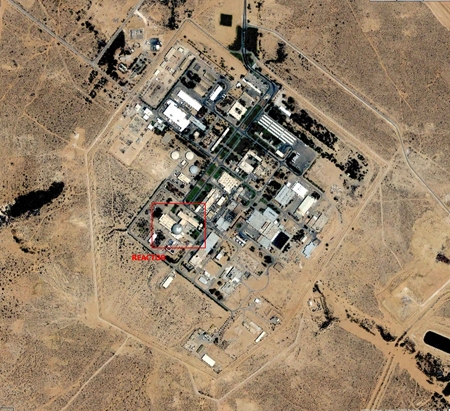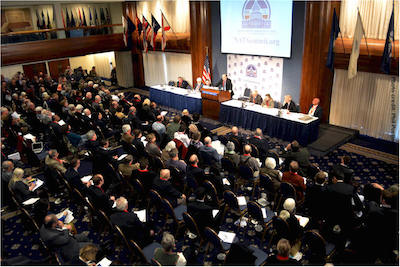How Israel’s Dimona nuclear reactor was concealed from the U.S. – Ha’aretz
Apr 15 2015 / 12:35 pm
New Documents on how Israel hid its nuclear weapons program from the U.S.
Amir Oren, Ha’aretz – One of the most fascinating historical turning points in the saga of nuclear development in the Middle East links Israel to Iran: the current prospect of the Iranians purchasing Russian S-300 ground-to-air missiles to protect their nuclear facilities from an Israeli or American attack shares a striking similarity to Israel’s purchase of American Hawk missiles to defend its own nuclear reactor in Dimona. Fulfilling that wish was the real aim of a deal that the government of Prime Minister David Ben-Gurion sought to strike in the late 1950s and early 1960s from the Kennedy and Eisenhower administrations.
Beyond the official explanation — the need to defend Israeli air force bases, population centers and reserve recruits from Egyptian aerial bombing – there was another unseen aspect of the deal, relating to Dimona. The Hawk missiles also served to defend the nuclear reactor located there, and during the 1967 Six-Day War were deployed to bring down an Israeli plane piloted by Captain Yoram Harpaz that strayed into the airspace around the reactor after being hit over Jordan during a bombing raid.
Many of the details surrounding Israel’s nuclear story have already been revealed through research and via the declassification of secret information [first by author Stephen Green’s books], including information released by the U.S. government – but there was more to be mined. Nuclear history researchers Avner Cohen, and Bill Burr are releasing a new trove of old documents this week on the Website of the National Security Archive of George Washington University in Washington, providing new angles on the story. Two of them are especially eyebrow-lifting: The role played by Richard Kerry, (the father of current U.S. Secretary of State John Kerry) and the story behind the birth of the tale that the Dimona reactor was ‘only’ a textile factory.
Hiding the program from its American “ally”
Cohen – who is a professor at the Middlebury Institute of International Studies at Monterey – and Burr document the principal effort on Israel’s part to forge atomic ties with France – a supplier of equipment and knowhow – and with Norway, which had agreed (together with Britain, which wanted to get rid of its overstocks from Norway) to sell the essential heavy water to run the reactor. Then there was the secondary goal – of hiding everything from the Americans until the Dimona reactor was an established fact. For nearly four long years, between 1957 and 1960, the effort to hide the project was crowned a success, either due to steps that Israel and France took to protect the information or due to intelligence failures in the gathering, analysis and inter-agency coordination of various professionals and political figures in Washington.
The cumulative result was that while the Americans had their suspicions and tried to sniff things out, they didn’t know for certain. As they had been in the Sinai-Suez military campaign of 1956, the Eisenhower administration was surprised by the depth of the Israeli-French cooperation. And as before, in late 1960, around the time of the U.S. presidential election, there was another surprise – although this time Eisenhower was nearing the end of his final term and could not seek re-election, instead passing the mantle to his successor, John Kennedy.
Secretary of State Kerry, who is currently up to his neck in the negotiations over Iran’s nuclear program, can find dispatches in the State Department archives – or through Cohen and Burr – that his father sent from the Norwegian capital concerning Israel’s nuclear program. The elder Kerry, who served as secretary of the U.S. embassy in Norway, reported in the summer of 1959 on conversations between American and Norwegian officials from the two countries’ nuclear energy commissions, and about his subsequent efforts to look further into the issue of the sale of heavy water to Israel. The secrecy, the Norwegians explained, was designed to avoid attracting the attention of officials enforcing the Arab boycott of Israel with regard to the companies involved in the heavy water transaction. Two other reasons cited were Norwegian participation in the United Nations emergency force in Sinai (and on other Arab-Israeli cease-fire lines) and contacts with Egypt over the sale of nuclear equipment for research and medical purposes.
Official Israel continues to maintain to this day, 45 years after the disclosure of the efforts to build the facility at Dimona, that its declared purpose was “part of the national effort to develop the Negev, extensive research, study and applied activity aimed at expanding basic knowledge and to further economic development.” From the moment it was caught, Israel admitted the nuclear goal – but stressed that like the small Sorek reactor, Dimona was meant for peaceful purposes. One can assume it wasn’t all just a show of innocence. The U.S. strategic air command also boasted during the Cold War that peace was its aim, that arming itself with nuclear missiles and bombers was designed to deter war.
And when it comes to the textile factory as cover for the Dimona project, researchers from the National Security Archive dug up its origins in a helicopter ride that 35-year-old American Ambassador Ogden Reed took over the northern Negev in the summer of 1960. Reed asked Addy Cohen (no relation to Avner Cohen) of the Israeli Finance Ministry for an explanation for the extensive earthmoving work in the area. Cohen, who was a close associate of Finance Ministers Levy Eshkol and Pinhas Sapir, had worked at the Israeli embassy in Washington (where he met and married Israeli statesman Abba Eban’s secretary). Cohen was well aware of the economic pressures that Eisenhower had applied on Ben-Gurion in 1956 and was also aware of the difficulties that were being encountered at the Finance Ministry over funding for the nuclear reactor.
Cohen was also concerned (and justifiably so, according to the internal documents of the Eisenhower administration) over a loss of American aid to Israel and the prospect that the tax-deductible status of American Jewish contributions to Israel would be eliminated. He preferred to provide a half-truth over total fabrication. He knew that Jerusalem architect Rudolf Trostler was planning industrial facilities in development towns in the Negev, including “Dimona Fibers” near the beginning of the Dimona-Eilat highway. “It’s a textile factory,” Cohen told the ambassador, winging it.
And while Israel was consumed with political scandal in the so-called [false flag] “Lavon Affair” and a threat of a schism in the ruling Mapai party, (predecessor to today’s Labor Party) Israel’s ambassador in Washington Avraham Harman attempted to promote a “calming” version of the Dimona project before the Kennedy administration. It was nothing but “a simple story,” Harman attempted to persuade Assistant Secretary of State Lewis Jones in February 1961, about two months after the project was uncovered. There is plenty of time and no plutonium, Harman told Jones, seeking to convince him that no reactor would be operating for at least two years. The Israelis, Harman said, could not conceive why there should be continuing interest in Dimona in the United States or anywhere else.
In addition to the memorandum of the conversation, the official papers include a summary of the position of the U.S. Joint Chiefs of Staff after the power of the Shah of Iran was undermined. Iran was a weak link in Western defense, the new defense secretary Robert McNamara was informed, and the Shah’s regime was problematic. Any alternative to the Shah seemed worse from the standpoint of American interests, but a readiness was required to shift from support for the Shah if he was on the verge of being overthrown. That, essentially, is what the Carter administration did in the late 1970s, in the face of the revolution led by Ayatollah Ruhollah Khomeini.

